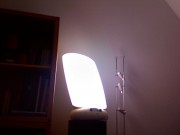
light therapy lamp
In the September issue of the journal Behavior Therapy, University of Vermont psychologist Kelly Rohan presents the first published research study of the long-term effects of different treatments for seasonal affective disorder (SAD), a form of severe depression that occurs annually in the fall and winter seasons. The first year Rohan randomized 69 people with SAD into one of four groups: light therapy treatment, cognitive behavior therapy (CBT), a combination of the two or a wait-list control. She then surveyed participants on how they were doing the next winter – one year later.
Of those treated with CBT, only 7 percent had a recurrence compared to 36.7 percent of people treated with light therapy. The recurrence rate for the combination group was 5.5 percent. When Rohan looked at the severity of the depression that did occur, however, CBT was associated with less severe depression than those treated with either light therapy or a combination of both.
In a previous study that measured the acute affects of each treatment (immediately following six weeks of intervention), combination therapy was highly effective, with a nearly 80 percent remission rate compared to 50 percent for both CBT and light therapy alone and 20 percent on the wait-list.
Rohan hypothesizes that such dramatic results for the combination therapy are the result of being in a heavily monitored study with full participation. When people are left on their own to manage symptoms the subsequent winter, follow-through is much more difficult. This “watered-down” effect of a two-modality treatment, Rohan notes, has been reported for 20 years across psychology disorders of all sorts.
“People treated with only CBT – that’s all they know,” she says, “so I think they do it with gusto in the next year and reap the benefits.”
Of the light therapy group, only four people used it on their own the following winter. Rohan considers this unsurprising given the commitment the treatment requires: 30 minutes sitting in front of a light box every day through the difficult season. Her data shows that long-term compliance is rare.
A $2 million, five-year grant from the National Institute of Mental Health will advance the next phase of Rohan’s research. In the “Cadillac” version of the trial, as she calls it, Rohan will follow a much larger sample, 160 people, over two consecutive winters. That study, in progress now, will compare only CBT and light therapy.
“The combination therapy may blow your socks off across six weeks of the initial winter,” says Rohan, “but if it doesn’t have good long-term outcomes, what is the point? This is a recurrent depression. It’s going to come back every year in some form and I want to develop treatments that are going to have lasting effects.”
Source: University of Vermont
